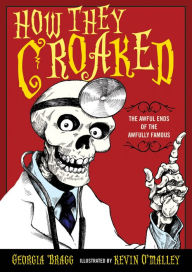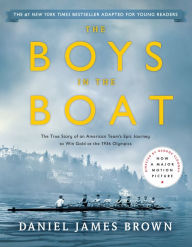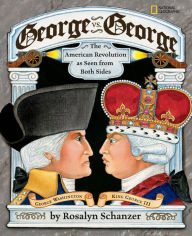Over the course of history men and women have lived and died. In fact, getting sick and dying can be a big, ugly mess-especially before the modern medical care that we all enjoy today. How They Croaked relays all the gory details of how nineteen world figures gave up the ghost. For example:
It is believed that Henry VIII's remains exploded within his coffin while lying in state.
Doctors "treated" George Washington by draining almost 80 ounces of blood before he finally kicked the bucket.
Right before Beethoven wrote his last notes, doctors drilled a hole in his stomach without any pain medication.
Readers will be interested well past the final curtain, and feel lucky to live in a world with painkillers, X-rays, soap, and 911.
From the Publisher
O'Malley's cartoon portraits and spot art add just the right notes of humor to keep the contents from becoming too gross. This all-too-informative study deserves the wild popularity it will without doubt acquire.” —Booklist, starred review“The most reluctant of readers will find it difficult to resist this consistently disgusting chronicle of the gruesome deaths of 19 will famous people. Bragg's informal, conversational style and O'Malley's cartoon illustrations complement the flippant approach to the subject; the energetically icky design includes little skulls and crossbones to contain page numbers. Engaging, informative and downright disgusting.” —Kirkus
“Bragg holds forth on nineteen Big Names whose demises have raised eyebrows, questions, and probably a few lunches... Carried away on a swift-flowing stream of body fluids, medical ineptitude, and O'Malley's deliciously snarky artwork, kids will agree they got exactly what they came for.” —BCCB
VOYA - Bethany Martin
In this gruesomely funny volume, Bragg examines the lives and deaths of nineteen historical figures, from King Tut to Albert Einstein. Sure to appeal to middle school students, this book highlights the peculiar and gross aspects of individual deaths, such as Henry VIII exploding in his coffin, or the use of blister beetles to treat George Washington. Interesting facts about related subjects are included between the chapters. O'Malley's black and white drawings compliment the text and add humor. While generally well researched and well written, the book can, at times, perpetuate stereotypes and generalizations; for example, stating that "things were perfect" for Pocahontas before the English arrived and that the English of 1615 bathed only once a year. There are also a few factual errors, such as stating Elizabeth I and Bloody Mary were stepsisters rather than half-sisters; however, these errors are minor. Bragg has definite opinions on most of her subjects and is not afraid to share them, calling Charles Darwin "a few cards short of a full deck," and Henry VIII a "hateful, 320-pound ogre." Because of the irreverent style used through out the book, some readers may have trouble separating facts from opinion and hyperbole. Teens, however, looking to get their fill of gory, gross, and funny, will not be disappointed. It will be a popular addition in school and public library collections serving middle school students. Reviewer: Bethany Martin
School Library Journal
Gr 5–9—Georgia Bragg has her tongue firmly in cheek as she describes "how some of the most important people who ever lived—died" in this engaging book (Walker, 2011). Beginning with King Tut and moving chronologically through to Albert Einstein, Bragg explains in a conversational style what maladies brought 19 of the great ones down. Listeners will be clued in to Henry VIII's gluttony, George Washington's little mouth of horrors, and James Garfield's oh-so-slow death by ignorance. Narrator L.J. Ganser uses sarcasm, timing, pauses, and tone to wring out every last ounce of disgusting, gross misery from the deaths of Julius Caesar, Cleopatra, Christopher Columbus, Napoleon, Mozart, and others. There are humorous subtitles to each story, such as "Marie Curie: You Glow Girl!," and sidebars that add to the history. Be sure to pair this with the print version so students can giggle at Kevin O'Malley's hysterical illustrations. A perfect choice for boys who are reluctant readers.—Tricia Melgaard, formerly Centennial Middle School, Broken Arrow, OK
Kirkus Reviews
The most reluctant of readers will find it difficult to resist this consistently disgusting chronicle of the gruesome deaths of 19 will famous people. Bragg opens with King Tut, discussing in gory details the embalming and mummification processes of the ancient Egyptians. Among the many macabre details is an explanation for why mummy eye sockets look empty: "Eyeballs shrink to almost nothing during the drying process" (the author notes that if mummy eyeballs are rehydrated, they return to almost normal size). Among the other famous figures profiled are Henry VIII, whose corpse exploded in its coffin while lying in state; George Washington, who was drained of 80 ounces of his blood by doctors before dying; and Marie Curie, who did herself in with constant radiation exposure. The accounts of how ill or injured people were treated by doctors through the 19th century reveal that medical practices were usually more lethal than the maladies. Between each chapter, there is a page or two of related and gleefully gross facts. Bragg's informal, conversational style and O'Malley's cartoon illustrations complement the flippant approach to the subject; the energetically icky design includes little skulls and crossbones to contain page numbers. Engaging, informative and downright disgusting. (sources, further reading, websites, index)(Nonfiction. 10-14)
Read More














